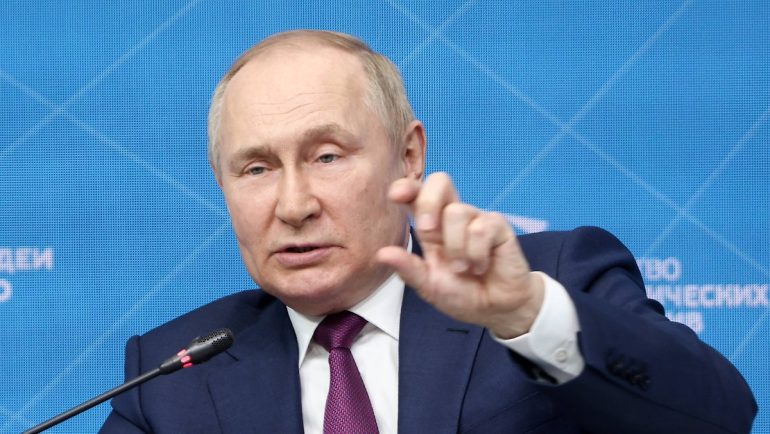Gazprom refused to accept
Putin presented turbines to Germany
Putin presented turbines to Germany
by Jan Ganger
07/26/2022, 2:55 pm
The federal government wants to make it possible to transport Nord Stream turbines from Canada to Russia. But the device is stuck in Germany. Because energy giant Gazprom prefers to gradually shut down gas to Germany.
That’s not really a surprise: Starting Wednesday, even less gas is going to flow through the Nord Stream 1 Baltic Sea pipeline in Germany, and Russia’s energy giant Gazprom will continue to throttle deliveries. Kremlin ruler Vladimir Putin made the promise last week, referring to turbines serviced in Canada that had not yet arrived at the compressor station in Portovaya, Russia. Apart from this, one more unit will have to be repaired soon.
And it is with these justifications that Gazprom and the Kremlin justify cutting new supplies. The German government considers the arguments presented by the Russian side to be false. The turbine is just a spare part, Russia can deliver more gas without it. As weak as Gazprom’s justification is, further cuts in deliveries are a disgrace to the traffic light alliance.
The Canadian government had banned the delivery of service turbines due to its own restrictions imposed on Russia. So the German Foreign Ministry put Canadians under pressure with a stern warning. If Putin uses the absence of turbines as an excuse and completely blocks gas in Germany, there could be a popular uprising in Germany. The Canadian government then allowed the turbine to be exported to Germany. It is to be transported to Russia through this stopover.
The federal government had repeatedly argued that the delivery was intended to give the Kremlin an excuse to stop gas supplies. However, she did not succeed. Because Russia refused to import it – and the turbine is said to have been stuck in Germany.
Gazprom lacks documents
With everything ready for transportation, deliveries can begin immediately, according to manufacturer Siemens Energy. According to a statement, the company “already had all the necessary documents for export from Germany to Russia at the beginning of last week and also informed Gazprom about the same.” “What is missing, however, is the customs documents required for import into Russia.” Only the customer can provide this information.
According to Siemens Energy, maintenance of the turbines is routine. There have been “no significant complications” in the past ten years. Current approval from the Government of Canada also stipulates that further Siemens Energy turbines can be serviced in Montreal and then exported. “Therefore we do not see any correlation between turbines and implemented or announced gas throttling at this time.”
However, the customer does not currently intend to take over the turbine. Gazprom justifies this with the missing documents. It is not clear whether the delivery does not violate Canadian restrictions. There are also questions about sanctions imposed on Russia by the EU and the UK. This is a problem not only with the delivery of this turbine, but also with the maintenance of other units.
step by step less gas
It is not officially known where the twelve meter long turbine is located. According to information received from the Russian business newspaper Kommersant, she reached Germany by cargo plane on 17 July. Then it was to be transported by ship across the Baltic Sea to Finland and then overland to the Russian border. It said onward transport by ferry to Helsinki last Saturday had failed.
Federal Economics Minister Robert Hebek said the “cabal around the turbine from Canada” was an example of Russia’s politicization of technical issues. “Sometimes there is a perception that Russia no longer wants to take them back,” the Green politician said. Still, the federal government wanted to make delivery possible and still wants to.
Meanwhile, the Russian government is continuing its strategy. Since June, the state-controlled Gazprom Group has been gradually cutting off gas supplies to Germany. In June, Nord Stream 1 cut supply to 40 percent of maximum capacity and shipped the turbine to Canada for repairs. During the ten-day routine maintenance, no gas flowed through the main supply pipeline to Germany. Gas distribution was resumed last Thursday – but still reduced to 40 percent. From this Wednesday the amount is to be reduced to 20 per cent of the maximum capacity. Reason: Another turbine repair.
“It is clear that Russia wants to provoke an energy crisis in Europe,” said Janice Kluge of the German Science and Politics Foundation (SWP) in an interview with ntv.de. “There is no alternate reality where we help Ukraine resist Russian aggression and where Russia continues to supply us with gas.”

Devoted web advocate. Bacon scholar. Internet lover. Passionate twitteraholic. Unable to type with boxing gloves on. Lifelong beer fanatic.





